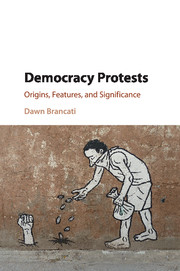Book contents
- Frontmatter
- Dedication
- Contents
- List of Figures
- List of Tables
- Acknowledgments
- 1 Introduction
- 2 Characteristics of Democracy Protests
- 3 Relating Economic Crises to Democracy
- 4 Analyzing the Rise of Democracy Protests
- 5 Analyzing Elections as Trigger Events
- 6 Historical Trends in Government Responses
- 7 Analyzing Political Accommodation
- 8 Historical Trends in Democratization
- 9 Analyzing Democratization
- 10 Conclusion
- Appendix: Data and Measures
- References
- Index
1 - Introduction
Published online by Cambridge University Press: 05 September 2016
- Frontmatter
- Dedication
- Contents
- List of Figures
- List of Tables
- Acknowledgments
- 1 Introduction
- 2 Characteristics of Democracy Protests
- 3 Relating Economic Crises to Democracy
- 4 Analyzing the Rise of Democracy Protests
- 5 Analyzing Elections as Trigger Events
- 6 Historical Trends in Government Responses
- 7 Analyzing Political Accommodation
- 8 Historical Trends in Democratization
- 9 Analyzing Democratization
- 10 Conclusion
- Appendix: Data and Measures
- References
- Index
Summary
Democracy protests have come and gone throughout history with varying degrees of success. While some democracy protests have resulted in full-fledged democracies, others have introduced no more than a few modest reforms. In South Korea, for example, after massive student-led protests arose demanding direct presidential elections among other things, the government agreed to implement major democratic reforms ahead of the 1988 Seoul Olympics. While South Korea celebrated more than ten years of consolidated democracy, Serbia embarked on its own transition to democracy. In 2000, hundreds of thousands of Serbs overtook the streets of the capital Belgrade and forced Slobodan Milošević to hand over power to his opponent Vojislav Koštunica, the winner of the country's presidential election. Outside of Asia and Europe, in the Middle East and North Africa, democracy protests have resulted in smaller-scale reforms, including the lifting of demands on certain political parties and the expansion of the right to vote, in the last decade.
In other countries, demands for more open and competitive elections have been ignored, as they were in the 2014 Hong Kong Umbrella Protests or, still worse, have resulted in backlashes against democracy and the rise of more authoritarian regimes. After tens of thousands of Russians mobilized against alleged fraud in the 2011 Duma elections, the Russian government drastically raised fines against unauthorized protests, adopted laws that branded nongovernmental organizations accepting aid from abroad as “foreign agents,” and intensified arrests of regime opponents. At times, democracy protests have even provoked backlashes against democratic freedoms outside the countries in which they have occurred. In order to forestall the Arab Spring protests from reaching its borders, China's communist-controlled government restricted already limited internet freedoms, stepped up arrests of political activists, and even banned jasmine flowers, the symbol of the 2011 Tunisian Revolution.
More often, states have used forceful means to repress democracy protests. In Bahrain, military forces, flanked by troops from the Gulf States, evicted democracy protesters from Pearl Roundabout, the site of the 2011 Bahraini Uprising, before setting ablaze and razing the historical landmark. In 2007, Burma's military junta cracked down violently on democracy protests, beating and arresting thousands of demonstrators, even raiding the monasteries of Buddhist monks who spearheaded the protests.
- Type
- Chapter
- Information
- Democracy ProtestsOrigins, Features, and Significance, pp. 1 - 17Publisher: Cambridge University PressPrint publication year: 2016



